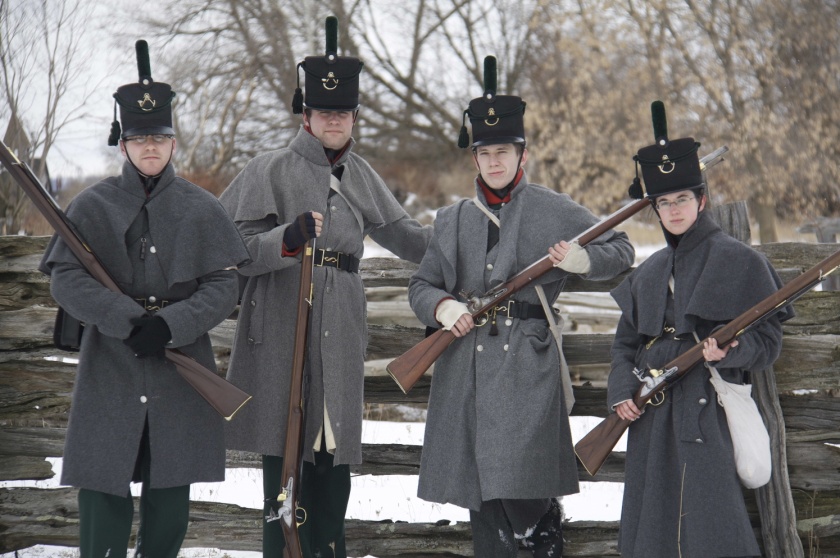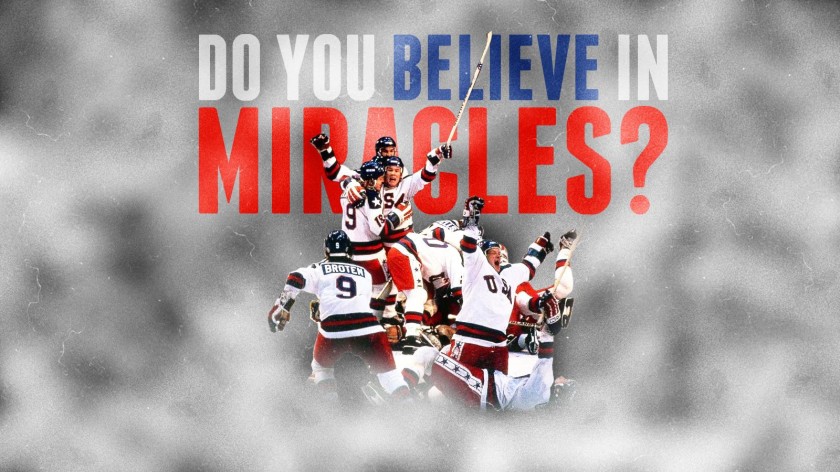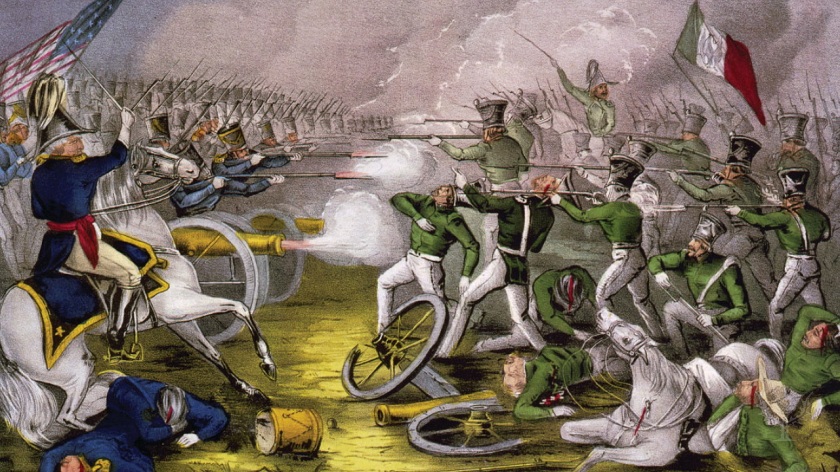It’s Thursday! Did You Know…
* 1813 – George Macdonnell leads raid on US Fort Ogdensburg.
The Battle of Ogdensburg was a battle of the War of 1812. The British gained a victory over the Americans and captured the village of Ogdensburg, New York. Although small in scale, it removed the American threat to British supply lines for the remainder of the war.
When the war broke out, a flourishing illicit trade was soon established between Ogdensburg and Prescott, Upper Canada (later to become the province of Canada West in 1841), on the Northern side of the Saint Lawrence River. This was checked early in October 1812 when the Americans reinforced the militia with some of the regular 1st U.S. Rifle Regiment under Major Benjamin Forsyth.
The British made an abortive attack with their own militia on October 3, which was quickly repulsed by the American forces in Ogdensburg, after which the militia dispersed. During the next few months, Forsyth’s riflemen made several raids across the river, sniping at British troops and occasionally capturing boatloads of supplies on their way to Kingston, Ontario.
On February 21, 1813, Lieutenant General Sir George Prevost, the British Governor General of Canada, passed through Prescott on his way to review the situation in Upper Canada, accompanied by several detachments of reinforcements. He appointed Lieutenant Colonel “Red George” MacDonell as commandant of British troops in Prescott and left him instructions that he was to attack Ogdensburg only if the Americans weakened their garrison.
The reinforcements, although there temporarily, allowed MacDonnell to improvise. He planned for a company of the Glengarry Light Infantry, 70 militia and some light guns mounted on sleighs to make a frontal attack on the fort which housed Forsyth’s riflemen. The main column, consisting of 120 men of the 8th (King’s), 30 of the Royal Newfoundland Fencibles and 230 of the local militia flank companies, would cross the river lower down and attack from the flank.
The Americans were used to seeing British troops drilling on the frozen Saint Lawrence and were taken by surprise when they suddenly charged. The riflemen in the fort held out against the frontal attack, mainly because the British guns became stuck in snow drifts, and American artillery, under Adjutant Daniel W. Church of Colonel Benedict’s regiment and Lieutenant Baird of Forsyth’s company, fired on the British with mixed results. As the British main body threatened to surround them, they retreated and abandoned the town. The militia retreated back into the civilian population. The artillery under Church and Baird managed to put up a tough resistance until both Church and Baird were wounded. The British then took control of the town.
The British burned the boats and schooners frozen into the ice, and they carried off artillery and military stores. There was some looting of private property, but some of the plundered goods were later returned.
After the British withdrew, the Americans did not re-garrison Ogdensburg. The British were able to purchase supplies from American merchants there for the remainder of the war. The Ogdensburg area may have been populated by more Tories and Federalists than was previously thought.

* 1980 U.S. hockey team makes miracle on ice
In one of the most dramatic upsets in Olympic history, the underdog U.S. hockey team, made up of college players, defeats the four-time defending gold-medal winning Soviet team at the XIII Olympic Winter Games in Lake Placid, New York. The Soviet squad, previously regarded as the finest in the world, fell to the youthful American team 4-3 before a frenzied crowd of 10,000 spectators. Two days later, the Americans defeated Finland 4-2 to clinch the hockey gold.
The Soviet team had captured the previous four Olympic hockey golds, going back to 1964, and had not lost an Olympic hockey game since 1968. Three days before the Lake Placid Games began, the Soviets routed the U.S. team 10-3 in an exhibition game at Madison Square Garden in New York City. The Americans looked scrappy, but few blamed them for it–their average age, after all, was only 22, and their team captain, Mike Eruzione, was recruited from the obscurity of the Toledo Blades of the International League.
Few had high hopes for the seventh-seeded U.S. team entering the Olympic tournament, but the team soon silenced its detractors, making it through the opening round of play undefeated, with four victories and one tie, thus advancing to the four-team medal round. The Soviets, however, were seeded No. 1 and as expected went undefeated, with five victories in the first round.
On Friday afternoon, February 22, the American amateurs and the Soviet dream team met before a sold-out crowd at Lake Placid. The Soviets broke through first, with their new young star, Valery Krotov, deflecting a slap shot beyond American goalie Jim Craig’s reach in the first period. Midway through the period, Buzz Schneider, the only American who had previously been an Olympian, answered the Soviet goal with a high shot over the shoulder of Vladislav Tretiak, the Soviet goalie.
The relentless Soviet attack continued as the period progressed, with Sergei Makarov giving his team a 2-1 lead. With just a few seconds left in the first period, American Ken Morrow shot the puck down the ice in desperation. Mark Johnson picked it up and sent it into the Soviet goal with one second remaining. After a brief Soviet protest, the goal was deemed good, and the game was tied.
In the second period, the irritated Soviets came out with a new goalie, Vladimir Myshkin, and turned up the attack. The Soviets dominated play in the second period, outshooting the United States 12-2, and taking a 3-2 lead with a goal by Aleksandr Maltsev just over two minutes into the period. If not for several remarkable saves by Jim Craig, the Soviet lead would surely have been higher than 3-2 as the third and final 20-minute period began.
Nearly nine minutes into the period, Johnson took advantage of a Soviet penalty and knocked home a wild shot by David Silk to tie the contest again at 3-3. About a minute and a half later, Mike Eruzione, whose last name means “eruption” in Italian, picked up a loose puck in the Soviet zone and slammed it past Myshkin with a 25-foot wrist shot. For the first time in the game, the Americans had the lead, and the crowd erupted in celebration.
There were still 10 minutes of play to go, but the Americans held on, with Craig making a few more fabulous saves. With five seconds remaining, the Americans finally managed to get the puck out of their zone, and the crowd began counting down the final seconds. When the final horn sounded, the players, coaches, and team officials poured onto the ice in raucous celebration. The Soviet players, as awestruck as everyone else, waited patiently to shake their opponents’ hands.
The so-called Miracle on Ice was more than just an Olympic upset; to many Americans, it was an ideological victory in the Cold War as meaningful as the Berlin Airlift or the Apollo moon landing. The upset came at an auspicious time: President Jimmy Carter had just announced that the United States was going to boycott the 1980 Summer Games in Moscow because of the Soviet invasion of Afghanistan, and Americans, faced with a major recession and the Iran hostage crisis, were in dire need of something to celebrate. After the game, President Carter called the players to congratulate them, and millions of Americans spent that Friday night in revelry over the triumph of “our boys” over the Russian pros.
As the U.S. team demonstrated in their victory over Finland two days later, it was disparaging to call the U.S. team amateurs. Three-quarters of the squad were top college players who were on their way to the National Hockey League (NHL), and coach Herb Brooks had trained the team long and hard in a manner that would have made the most authoritative Soviet coach proud. The 1980 U.S. hockey team was probably the best-conditioned American Olympic hockey team of all time–the result of countless hours running skating exercises in preparation for Lake Placid. In their play, the U.S. players adopted passing techniques developed by the Soviets for the larger international hockey rinks, while preserving the rough checking style that was known to throw the Soviets off-guard. It was these factors, combined with an exceptional afternoon of play by Craig, Johnson, Eruzione, and others, that resulted in the miracle at Lake Placid.
This improbable victory was later memorialized in a 2004 film, Miracle, starring Kurt Russell.

* 1819 The U.S. acquires Spanish Florida
Spanish minister Do Luis de Onis and U.S. Secretary of State John Quincy Adams sign the Florida Purchase Treaty, in which Spain agrees to cede the remainder of its old province of Florida to the United States.
Spanish colonization of the Florida peninsula began at St. Augustine in 1565. The Spanish colonists enjoyed a brief period of relative stability before Florida came under attack from resentful Native Americans and ambitious English colonists to the north in the 17th century. Spain’s last-minute entry into the French and Indian War on the side of France cost it Florida, which the British acquired through the first Treaty of Paris in 1763. After 20 years of British rule, however, Florida was returned to Spain as part of the second Treaty of Paris, which ended the American Revolution in 1783.
Spain’s hold on Florida was tenuous in the years after American independence, and numerous boundary disputes developed with the United States. In 1819, after years of negotiations, Secretary of State John Quincy Adams achieved a diplomatic coup with the signing of the Florida Purchase Treaty, which officially put Florida into U.S. hands at no cost beyond the U.S. assumption of some $5 million of claims by U.S. citizens against Spain. Formal U.S. occupation began in 1821, and General Andrew Jackson, the hero of the War of 1812, was appointed military governor. Florida was organized as a U.S. territory in 1822 and was admitted into the Union as a slave state in 1845.

* 1847 Battle of Buena Vista begins
During the Mexican-American War, Mexican General Santa Anna surrounds the outnumbered forces of U.S. General Zachary Taylor at the Angostura Pass in Mexico and demands an immediate surrender. Taylor refused, allegedly replying, “Tell him to go to hell,” and early the next morning Santa Anna dispatched some 15,000 troops to move against the 5,000 Americans. The superior U.S. artillery was able to halt one of the two advancing Mexican divisions, while Jefferson Davis’ Mississippi riflemen led the defense of the extreme left flank against the other Mexican advance. By five o’clock in the afternoon, the Mexicans begin to withdraw.
The Mexican-American War began with a dispute over the U.S. government’s 1845 annexation of Texas. In January 1846, President James K. Polk, a strong advocate of westward expansion, ordered General Taylor to occupy disputed territory between the Nueces and the Rio Grande rivers. Mexican troops attacked Taylor’s forces, and in May 1846 Congress approved a declaration of war against Mexico.
At Buena Vista in February 1847, and at Monterrey in September, Taylor proved a brilliant military commander, earning the nickname “Old Rough and Ready” while emerging from the war a national hero. He won the Whig presidential nomination in 1848 and defeated the Democratic candidate, Lewis Cass, in November. The other hero of the Battle of Buena Vista, Jefferson Davis, became secretary of war under President Franklin Pierce in 1853 and president of the Confederate States of America in 1861.

* 2006 Gang commits largest robbery in British history
In the early morning hours of February 22, 2006, a gang of at least six men, some of them armed, steal £53 million from the Securitas bank depot in Kent, Great Britain. It was the largest such theft in British history.
The plot was well planned. On the evening before, two men, dressed as police officers, pulled the depot manager, Colin Dixon, over as he was driving in nearby Stockbury. They convinced him to get out of his car and forced him into their vehicle. At about the same time, two more men visited Dixon’s home and picked up Dixon’s wife and eight-year-old son; eventually, all three Dixons were taken to a farm in West Kent, where the gang threatened their lives if Colin refused to cooperate with the robbery.
The Dixons were then forced to go with the gang to the Securitas depot, where Colin helped them evade the building’s security system. The gang proceeded to tie up 14 depot staff members, load the £53 million into a truck and, at about 2:15 a.m. on February 22, drive away. No one was injured in the robbery. Eventually, one depot worker was able to contact police, who launched a massive search for the culprits. As the stolen money was all in used bills, it was difficult to trace. Securitas and its insurers posted a £2 million reward for information leading to the arrests of the robbers and return of the money.
The next day, three people, one man, and two women were arrested in connection with the case; one had attempted to deposit £6,000 into a local bank that was bound in Securitas depot tape. However, all three were later released without being charged. Police continue to investigate the case, and more than 30 people have been arrested, though there have been no convictions. Police are also said to have recovered nearly £20 million of the stolen money.

Today’s Sources:
* Canadian History Timeline – Canada’s Historical Chronology http://canadachannel.ca/todayincanadianhistory/index.php
* Revolvy https://www.revolvy.com/main/index.php?s=Battle%20of%20Ogdensburg
* This Day In History – What Happened Today http://www.history.com/this-day-in-history/


Indeed it was!
LikeLiked by 1 person
There are three monumental moments I have witnessed, where I can recall every detail of where I was: 9/11, Kennedy’s assassination, and Miracle on Ice. It was the game before our hockey team took the gold. That was the Miracle on ice. Today USA beat the Canadians in curling; feels like a deja vu.
LikeLiked by 1 person
I think the wheels fell off our Olympic team this time. Congrats, Jennie!
LikeLiked by 1 person
I watched the faces of the Canadian team and their expressions. They seemed worried or concerned by round 7 or 8. It was a nail biter. Great game.
LikeLiked by 1 person
This is their second loss to the US team – and they’ve never lost to them before. I guess the Lucky Loonie got lost somewhere.
LikeLiked by 1 person
Yes, the Lucky Loonie must have been lost. Oh, no!
LikeLiked by 1 person
Right! And today the Germans dumped our men’s hockey team. Guess we used up all of the Loonie luck. 😢
LikeLiked by 1 person
I saw the third period… sad for the Canadians. No Loonie Luck. If it is any consolation, the US figure skaters were the worst they have been since WWII. Sigh!
LikeLiked by 1 person
On the bright side, this Olympic Games was the best medal haul for Team Canada in history.
LikeLiked by 1 person
I didn’t know that. Wonderful! Did you watch men’s curling? A Cinderella story for USA.
LikeLiked by 1 person
No, Jennie, I haven’t watched anything but news highlights. Good breakthrough for your men’s curling team!
LikeLiked by 1 person
The “Miracle on Ice” is a great story that transcends sports, but watching the very exciting sport of ice hockey makes me think of Canada.
LikeLiked by 1 person
It was very exciting – back in the bad old days when the Olympic authorities wouldn’t let the pros play. Yet the Soviets were pros – they were paid to play hockey by the military. Thanks, Bob.
LikeLiked by 1 person
That hockey game was a miracle on ice. I loved the idea of those guys making off with so much money. Some plan. Then the goober makes a deposit with the depot’s band around the money. Good post today
LikeLiked by 1 person
Hey, there’s an idea for another Top Ten List, John!
LikeLike
The map is fascinating, but then, I love maps. This one tells a story which helps me better understand the culture. Thank you, John.
LikeLiked by 1 person
Glad that map helps. Thanks, Gwen!
LikeLike
Interesting as always John.
LikeLiked by 1 person
Thanks, Opher.
LikeLike
I remember watching the U.S. Men’s Hockey Team take gold in 1980. My family was glued to every game, and oh, how we cheered at the end! A classic underdog story, it was indeed a shining moment in Olympic history. Thanks for the memory, John.
LikeLiked by 1 person
You’re welcome, Mae. Congrats on the Gold your women’s hockey team won last night against Canada. I really, really, really hate shootouts to decide hockey games. They don’t use foul shots to decide a tie basketball game, nor do they use homerun derbies to decide baseball games. They do the same thing in the NHL hockey games too. Let the teams play until they drop – or resume the game the following day. That’s my rant for today! Thanks, Mae!
LikeLiked by 1 person
LOL! I missed that game last night but I did see the news on Twitter and elsewhere. No doubt you’ll get us in another 4 years 🙂
LikeLiked by 1 person
If we do, I sincerely hope it won’t be decided by a final shootout!
LikeLiked by 1 person